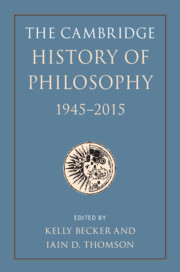Book contents
- The Cambridge History of Philosophy, 1945–2015
- The Cambridge History of Philosophy, 1945–2015
- Copyright page
- Contents
- Contributors
- Preface and Acknowledgments
- Introduction
- Part I Analytic Philosophy
- Section One Language, Mind, Epistemology
- Section Two Logic, Metaphysics, Science
- 10 Logic in the Second Half of the Twentieth Century
- 11 (Re)discovering Ground
- 12 Lewis’s Theories of Causation and Their Influence
- 13 Naturalism from the Mid-Twentieth Century to the Present
- 14 The History of Philosophy of Science
- 15 A Modern Synthesis of Philosophy and Biology
- Section Three Analytic Moral, Social, and Political Philosophy
- Section Four Analytic Aesthetics and Philosophy of Religion
- Part II Continental Philosophy
- Part III Bridge Builders, Border Crossers, Synthesizers, and Comparative Philosophy
- Part IV Epilogue: On the Philosophy of the History of Philosophy
- References
- Index
13 - Naturalism from the Mid-Twentieth Century to the Present
Quine’s “Hegelianism,” Armstrong’s Empiricism, and the Rise of Liberal Naturalism
from Section Two - Logic, Metaphysics, Science
Published online by Cambridge University Press: 08 November 2019
- The Cambridge History of Philosophy, 1945–2015
- The Cambridge History of Philosophy, 1945–2015
- Copyright page
- Contents
- Contributors
- Preface and Acknowledgments
- Introduction
- Part I Analytic Philosophy
- Section One Language, Mind, Epistemology
- Section Two Logic, Metaphysics, Science
- 10 Logic in the Second Half of the Twentieth Century
- 11 (Re)discovering Ground
- 12 Lewis’s Theories of Causation and Their Influence
- 13 Naturalism from the Mid-Twentieth Century to the Present
- 14 The History of Philosophy of Science
- 15 A Modern Synthesis of Philosophy and Biology
- Section Three Analytic Moral, Social, and Political Philosophy
- Section Four Analytic Aesthetics and Philosophy of Religion
- Part II Continental Philosophy
- Part III Bridge Builders, Border Crossers, Synthesizers, and Comparative Philosophy
- Part IV Epilogue: On the Philosophy of the History of Philosophy
- References
- Index
Summary
Naturalism as a philosophy of nature, what it consists in, and our ways of knowing nature (so conceived) has a long history in philosophy. In the twentieth century the question of naturalism has been, for the most part, centrally concerned with the question of philosophy’s relation to science, especially the natural (or “hard”) sciences. Its moral is that philosophy can no longer continue to think of itself as an autonomous discipline or stance distinct from science. I will proceed by examining in some detail the naturalisms of W. V. O. Quine and David Armstrong, which seem to align as a result of a commitment to what, at first, seem the same doctrines of Physicalism, Empiricism, and Metaphysical Realism. Against this perception of near-alignment I want to argue that they do not neatly line up on the naturalist side of the longstanding opposition between idealism and naturalism. In fact, in some key respects, Quine’s naturalism contains traces of idealism. The real opposition is between normativism and naturalism. I conclude by briefly contrasting two normativist positions – idealism and liberal naturalism – and come down in favor of the latter.
- Type
- Chapter
- Information
- The Cambridge History of Philosophy, 1945–2015 , pp. 171 - 188Publisher: Cambridge University PressPrint publication year: 2019



